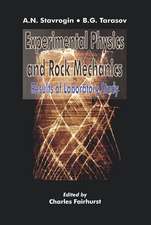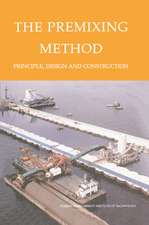Smith′s Elements of Soil Mechanics 10e
Autor I Smithen Limba Engleză Paperback – 22 sep 2021
The revised 10th edition of the core textbook on soil mechanics
The revised and updated edition of Smith's Elements of Soil Mechanics continues to offer a core undergraduate textbook on soil mechanics. The author, a noted expert in geotechnical engineering, reviews all aspects of soil mechanics and provides a detailed explanation of how to use both the current and the next versions of Eurocode 7 for geotechnical design. Comprehensive in scope, the book includes accessible explanations, helpful illustrations, and worked examples and covers a wide range of topics including slope stability, retaining walls and shallow and deep foundations.
The text is updated throughout to include additional material and more worked examples that clearly illustrate the processes for performing testing and design to the new European standards. In addition, the book's accessible format provides the information needed to understand how to use the first and second generations of Eurocode 7 for geotechnical design. The second generation of this key design code has seen a major revision and the author explains the new methodology well, and has provided many worked examples to illustrate the design procedures. The new edition also contains a new chapter on constitutive modeling in geomechanics and updated information on the strength of soils, highway design and laboratory and field testing. This important text:
- Includes updated content throughout with a new chapter on constitutive modeling
- Provides explanation on geotechnical design to the new version of Eurocode 7
- Presents enhanced information on laboratory and field testing and the new approach to pavement foundation design
- Provides learning outcomes, real-life examples, and self-learning exercises within each chapter
- Offers a companion website with downloadable video tutorials, animations, spreadsheets and additional teaching materials
Written for students of civil engineering and geotechnical engineering, Smith's Elements of Soil Mechanics, 10th Edition covers the fundamental changes in the ethos of geotechnical design advocated in the Eurocode 7.
Preț: 392.78 lei
Nou
75.15€ • 78.48$ • 62.06£
Carte disponibilă
Livrare economică 25 martie-08 aprilie
Livrare express 08-14 martie pentru 69.43 lei
Specificații
ISBN-10: 1119750393
Pagini: 704
Dimensiuni: 187 x 235 x 33 mm
Greutate: 1.23 kg
Ediția:10th Edition
Editura: Wiley
Locul publicării:Chichester, United Kingdom
Descriere
Smith's Elements of Soil Mechanics
The revised 10th edition of the core textbook on soil mechanics
The revised and updated edition of Smith's Elements of Soil Mechanics continues to offer a core undergraduate textbook on soil mechanics. The author, a noted expert in geotechnical engineering, reviews all aspects of soil mechanics and provides a detailed explanation of how to use both the current and the next versions of Eurocode 7 for geotechnical design. Comprehensive in scope, the book includes accessible explanations, helpful illustrations, and worked examples and covers a wide range of topics including slope stability, retaining walls and shallow and deep foundations.
The text is updated throughout to include additional material and more worked examples that clearly illustrate the processes for performing testing and design to the new European standards. In addition, the book's accessible format provides the information needed to understand how to use the first and second generations of Eurocode 7 for geotechnical design. The second generation of this key design code has seen a major revision and the author explains the new methodology well, and has provided many worked examples to illustrate the design procedures. The new edition also contains a new chapter on constitutive modeling in geomechanics and updated information on the strength of soils, highway design and laboratory and field testing. This important text:
- Includes updated content throughout with a new chapter on constitutive modeling
- Provides explanation on geotechnical design to the new version of Eurocode 7
- Presents enhanced information on laboratory and field testing and the new approach to pavement foundation design
- Provides learning outcomes, real-life examples, and self-learning exercises within each chapter
- Offers a companion website with downloadable video tutorials, animations, spreadsheets and additional teaching materials
Written for students of civil engineering and geotechnical engineering, Smith's Elements of Soil Mechanics, 10th Edition covers the fundamental changes in the ethos of geotechnical design advocated in the Eurocode 7.























